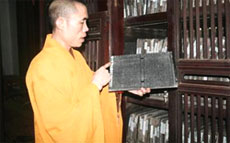A dossier on Truc Lam Zen Buddhism teaching wood blocks kept at a pagoda in Northern Province of Bac Giang has been submitted to UNESCO for its recognition as World Documentary Heritage in the Memory of the World Programme, according to the Ministry of Foreign Affairs.

The final decision will be announced at UNESCO's annual meeting in Warsaw, Poland, in May 2011.
The stock, which consists of more than 3,000 wood blocks dated between 17th and 19th century, has been preserved at Vinh Nghiem (also known as Duc La) Pagoda in Bac Giang's Yen Dung District.
The pagoda itself was built by the founder of Truc Lam Zen Buddhism, King Tran Nhan Tong, in the 11th century.
The blocks include Buddha's teaching, Buddhist works carved by artisans from Hai Duong Province and other localities in the North.
Tran Van Lang, director of Bac Giang Province Museum, said the blocks have been carved with Han Chinese script or nom (Vietnamese characters transformed from Han) on both sides.
Lang said that the whole content of the blocks had been available onto paper at the end of last year, after six-months of printing. The blocks had been put into ten book titles.
The blocks have been carved using the wood of the thi tree (a kind of persimmon), which is white, and hardly cracks. The wood is soft and easy for carving on when it is fresh and gets tougher and harder when it dries.
The s of blocks vary from the biggest of 1 by 0.5m and smallest of 0.15 by 0.2m in dimensions.
Veteran monk Thich Thanh Vinh, who is the head of Vinh Nghiem Pagoda said: "The blocks are now in good condition although they have been kept in fairly simple facilities for many years.
"The blocks are checked by monks at the pagoda three times a year. Because both sides of the stocks are carved with characters, the move should be made carefully," he added, "That's why they have been well preserved despite harsh weather and war.
"The wood block stocks not only bear spiritual content, but also have other meanings," said Ngo Van Tru, Deputy Director of Bac Giang Department of Culture, Sports and Tourism.
"Through the collection, people can receive a range of information on the history of Buddhism, the theology, practice, and life of Truc Lam Zen Buddhism," he said.
The blocks also tell a history of wood block carving in Viet Nam, and the careers of some

eminent monks.
"Due to the wood carving skills of the artisans, each block is more like a unique piece of artwork and is a valuable material for doing research on the development of Vietnamese language and nom characters," he said.
"If this collection is recognised as World Documentary Heritage, its value will be shared with the whole world," monk Vinh said. "This treasure has been with Truc Lam Zen Buddhism for hundreds of years. We are planning to build a new storage facility to preserve the treasure by the end of this year."
The collection was recognised as national heritage in 1964 by the culture ministry.
Zen Buddhism was initiated by King Tran Nhan Tong (1258-1308), who abdicated the throne in favour of his son Tran Anh Tong in 1293 to become a Buddhist monk. He incorporated the three sects of Zen that had come to Vietnam (then called Dai Viet) from China, with the local names of Ty Ni Da Luu Chi, Vo Ngon Thong and Thao Duong into a Vietnamese Zen tradition, known as Truc Lam (Bamboo Forest).
This came after he had led royal troops in defeating Mongol invaders before retreating to Yen Tu Mountain to begin his religious life before travelling around the country to expound the dharma.
UNESCO earlier this year recognised 82 steles commemorating the graduation of royal mandarins from the 15th to 18th century at Hanoi's Temple of Literature as world documentary heritage.
The 82 stone steles are inscribed with the names of 2,313 doctorate holders who passed court examinations between 1442 and 1779 under the Le, Mac and Later-Le reigns.
The Nguyen Dynasty (1802-1945) wood block documents received the same title last year.